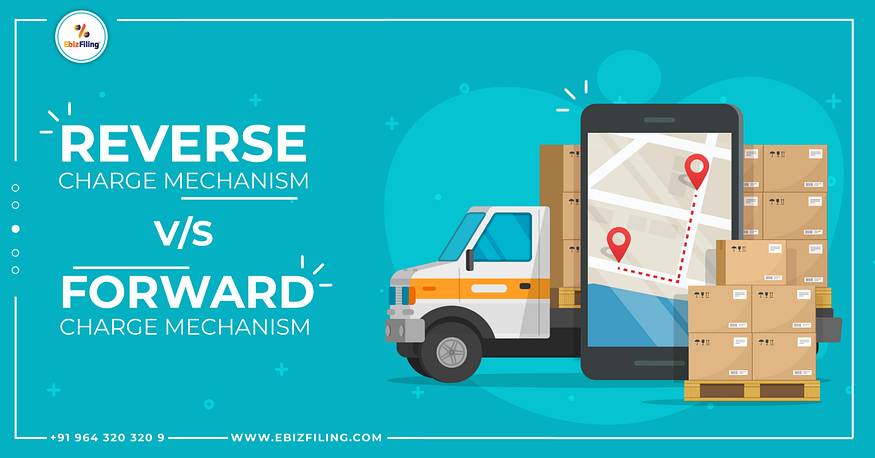Reverse Charge Mechanism v/s Forward Charge MechanismA Story by ishita ramaniReverse Charge Mechanism (RCM) and Forward Charge Mechanism (FCM) are two different methods of levying tax on goods and services. Introduction Reverse Charge Mechanism (RCM) and Forward Charge Mechanism (FCM) are two different methods of levying tax on goods and services. RCM is a system in which the recipient of goods or services is liable to pay tax to the government instead of the supplier. On the other hand, FCM is a system in which the supplier of goods or services is responsible for collecting and paying taxes to the government. What is reverse-charge mechanism?The reverse-charge mechanism is a tax collection method where the responsibility for paying and reporting tax is transferred from the supplier of goods or services to the recipient (buyer or receiver of services), which is mostly used in B2B transactions and in certain services to prevent tax evasion. What are the advantages of reverse-charge mechanism?RCM has both advantages and disadvantages. One of the advantages of the reverse-charge mechanism is that it helps prevent tax evasion. When the recipient is responsible for paying the tax, the supplier is less likely to avoid paying the tax. A descriptive table to know more about the advantages of reverse-charge mechanism is given below-: 1. Reduces tax evasion: The reverse-charge mechanism ensures that tax evasion is reduced, as it places the onus of paying tax on the receiver of goods or services. 2. Saves time and effort: Since the recipient is responsible for paying the tax, the supplier is relieved of the burden of compliance, which saves time and effort. 3. Increases cash flow: In the reverse-charge mechanism, the recipient is required to pay the tax, which means that the supplier does not have to pay the tax and can therefore increase their cash flow. 4. Promotes compliance: The reverse-charge mechanism encourages compliance, as it places the onus on the recipient and supplier to report and pay taxes correctly. What are the disadvantages of RCM?Reverse-charge mechanism (RCM) also has disadvantages. A disadvantage is that it can lead to cash flow problems for the recipient. The recipient has to pay the tax in advance and then claim the refund. This can lead to cash flow problems for the recipient, especially if they are a small business. This can be time-consuming and can lead to errors. A descriptive table to know more about some of the disadvantages of reverse-charge mechanism is given below-: 1. Increased complexity: The reverse-charge mechanism adds to the complexity of the tax system, as it requires transactions and proper documentation by both the supplier and recipient. 2. Burden on recipient: The recipient of goods or services is burdened with the responsibility of paying taxes, which can be challenging for small businesses or individuals. 3. Cash flow issues for the recipient: The recipient of the goods or services may experience cash flow problems, as they need to pay taxes in advance, which may affect their finances. 4. May lead to disputes: The reverse-charge mechanism can lead to disputes between the supplier and recipient regarding the payment of tax and the validity of invoices. What is forward charge mechanism?The term “forward charge mechanism” is not commonly used in accounting or taxtion law. In most tax systems, tax is collected using FCM, where the supplier or service provider is responsible for collecting and collecting the tax from the recipient at the point of sale, and then remits the tax to the tax authorities. What are the Advantages & Disadvantages of FCM?The forward-charge mechanism (FCM) also has advantages and disadvantages similar to RCM. One such advantage of FCM is that it is easier to administer. The supplier collects the tax and pays it to the government. It reduces the administrative burden on the recipient. Another benefit is that it helps prevent tax evasion. The supplier is responsible for collecting the tax, and they are less likely to avoid paying the tax. However, FCM also has its disadvantages. Small businesses need to register for GST and then collect and pay the tax to the government. This can be time-consuming and increase their compliance burden. A descriptive table to know more about the advantages and disadvantages of forward-charge mechanism is given below-: Advantages
Disadvantages
What is the difference between RCM & FCM?RCM and FCM are two different taxation systems used in different circumstances. In RCM, the recipient of goods or services is liable to pay tax to the government. This system is used in cases where suppliers of goods or services are not registered for GST (Goods and Services Tax) or are exempted from GST registration. This system is also used in cases where the supplier is not located in the recipient’s country. On the other hand, FCM is a system in which the supplier of goods or services is responsible for collecting and paying taxes to the government. FCM is used in cases where the supplier of goods or services is registered for GST and is located in the same country as the recipient. “Simplify GST payments online with ease. Explore secure and efficient solutions for hassle-free GST transactions. Pay GST online effortlessly and stay compliant, ensuring a seamless experience for your business.” Summary Reverse-charge mechanism and forward charge mechanism are two different taxation systems that are used in different circumstances. Both systems have advantages and disadvantages. RCM helps to put a stop on tax evasion and decreases the compliance burden for small businesses but can create cash flow problems and raise the administrative burden for the recipient. FCMs are easy to administer and help prevent tax evasion but can increase and increase the compliance burden for small businesses. © 2024 ishita ramani |
Stats
26 Views
Added on January 31, 2024 Last Updated on January 31, 2024 Author
|

 Flag Writing
Flag Writing